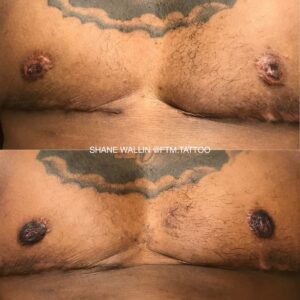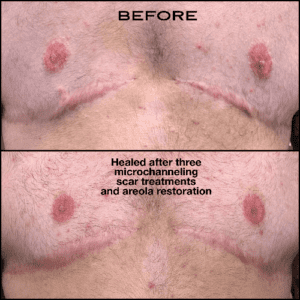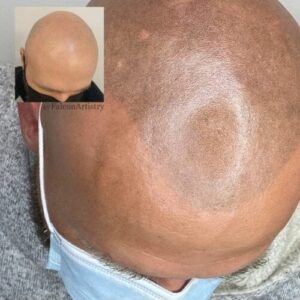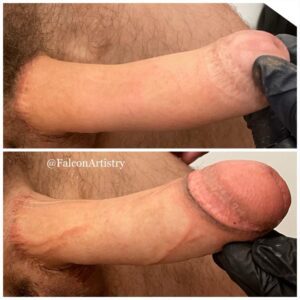Medical tattooing for surgical patients: what is nipple tattooing, scar tattooing and microneedling?
Medical tattooing and microneedling are common parts of the surgical journey and are often a patient’s final step in achieving their desired results. A nipple and areola tattoo is common for top surgery patients whose nipples have either been removed during surgery or for those who would like to alter the size, shape and color of their nipple grafts. Tattooing can also be used to recolor phalloplasties, conceal scars and increase the appearance of hair density on the scalp. Microneedling is an inkless tattoo needle therapy that can help with scar discoloration and flattening; in the case of scar tattooing, microneedling can make the tissue better able to accept the ink. Below you can find a list of before and aftercare guidelines for these services.
If you are interested in making medical tattooing or microneedling a part of your surgical journey, we have a list of three expert, trans-friendly artists that have worked successfully with GCC patients in the past. You can check out our top 3 recommended medical or restorative tattoo providers–in San Francisco, CA, San Diego, CA, and Vancouver, Canada–and an overview of their services here.
Nipple Tattoo and Areola Tattoo Options
Nipple and areola tattooing has been the most solicited medical or restorative tattoo service by GCC patients. Generally speaking, they are most often sought out by breast cancer survivors and top surgery patients who have undergone some form of mastectomy or breast/chest reduction. Some patients undergo multiple tattooing sessions so that the pigmentation holds properly, until they are otherwise completely satisfied with the appearance of their final results.
Nipple and areola tattoos can be a part of either a reactive or proactive approach to top surgery. By reactive, we refer to patients who are looking to correct complications from their surgery; for instance, responding to undesired scarring or tissue death, such as nipple grafts not surviving. Through pigmentation layering, a patient can correct the appearance of certain surgical complications to achieve more symmetrical, natural looking results. Restorative tattooing can alter the shape, size and coloring of both the areola and the nipple.
By the proactive approach to nipple and areola tattooing, we refer to giving patients the option to plan on getting hyper-real, 3D nipple and areola tattoos to avoid surgical nipple grafting altogether. To clarify, 3D nipple tattoos are made to appear 3D from pigmentation and shadowing techniques, but will not alter the actual projection of the skin. This option could be ideal for those who wish to have the appearance of nipples on their chest, but are not interested in the aftercare and complication risk involved in nipple grafting.
Scar Tattooing and Microneedling
For patients who are unsatisfied with the visibility of their scars–for instance, from top surgery, facial feminization surgery or a vaginoplasty–both scar tattooing and microneedling performed by a certified, experienced professional can be great options. If the scar tissue is lighter in color than the surrounding skin, scars can be tattooed over to blend them in. Generally speaking, a scar needs to have fully healed before it can be tattooed over; this means patients are expected to wait at least 12 months post-op before concealing a scar with tattoo ink. A qualified medical tattoo artist can use their expertise in color theory to match the scar to the desired skin tone in order to camouflage it. Each of the three tattoo artists we recommend also have extensive experience in helping patients cover scars with decorative tattoos as well. Decorative tattooing and microneedling are possible concealing and treatment options for hyperpigmented scars, which are darker than the surrounding skin.
Microneedling and microchanneling therapy are treatment options for hypo and hypertrophic scars that some medical tattoo artists offer. Both therapies are effective tools for accomplishing scar flattening, recoloring and can allow for the scar tissue to better accept the pigment of tattoo ink.
Traditional microneedling therapy involves running water through a 1” tattoo needle to crosshatch it across scar tissue. Microneedling results in scar relaxation and allows for collagen introduction to the tissue. Microchanneling scar therapy, offered by Jen Lee of Ed Hardy’s Tattoo City in San Francisco, is a similar procedure; however, it creates channels within the scar tissue and inserts pharmaceutical grade stem cell serum to help build back collagen in the scar tissue. Both therapies are performed over several sessions spaced-out a month apart. You can read more about the care instructions and guidelines for both types of microneedling therapy below.
Recoloring: Scalp Micropigmentation and Phalloplasty Tattooing
Scar camouflaging, nipple and areola tattoos are not the only tattooing services that fall under the gender affirming care umbrella. Scalp micropigmentation and phalloplasty coloring are also options patients can consider alongside or instead of gender affirming surgeries. Candice Falcon of Falcon Artistry Tattoo offers scalp micropigmentation for folks who experience dysphoria or dysmorphia around the shape of their hairline and/or the appearance of the thickness of their hair on their scalp. On the other hand, all three listed providers offer phalloplasty tattooing to add realistic pigmentation, dimensions, shadowing, and veins to someone’s results. Scar tattooing or microneedling therapy can also be used to conceal or treat the scar tissue located at the donor site for a phalloplasty. Generally speaking, phalloplasty pigmentation occurs over the course of two sessions with a 6-8 week gap in-between.
Before and aftercare for medical tattooing:
- Some providers of medical tattoos are insurance accredited. Ask your tattoo artist if they can help you file for insurance pre-approval or reimbursements for their services.
- For top surgery patients without healing complications, 3D nipples can be tattooed on at earliest 5 months after the final surgery. This means that the tattooing of a hyper-real nipple and areola should wait until at least 5 months after any revision surgeries have been realized.
- Generally speaking, scars cannot be tattooed until they have completely healed, which involves a waiting period of 12 months after surgery.
- Patients should avoid tanning or direct sun exposure to the desired area of the tattoo two weeks prior to and after each session.
- If a patient is allergic to Saniderm or adhesive or is prone to fainting, they should alert their tattoo artist before their first session.
- Patients are recommended to arrive well-rested, freshly bathed and having eaten a solid meal before their session.
- Each tattooing session begins with the artist applying a topical anesthesia to the area. If they are still worried about pain and discomfort, they can apply lidocaine 2 hours before the session.
- Some medical tattooing will require multiple sessions for the ink to hold. In this case, experts recommend that sessions have an 8-12 week gap between them.
- After each session, patients should avoid submerging the tattoo under water for a minimum of three weeks.
Before and aftercare for microchanneling and microneedling:
- For patients who have had botox, fillers, or threads, they must wait at least two weeks after threads or injections to receive either type of microneedling therapy to their face.
- Microneedling involves lightly cross hatching the scar tissue with water pumped out from a tattoo needle.
- Microchanneling is an inkless stamp on the skin that feels like a pinprick. It is common for the treated area to feel like a sunburn for a day or two afterward. Flaking and peeling of the skin treated is also normal.
- Patients should avoid accutane for 6 prior to their microchanneling therapy sessions and avoid retinol products (2% or higher) for 3 days in advance of the treatment.
- Patients who have been treated with PRP or PRF injections should drink an extra 24-32 oz of water for 2-3 days before microchanneling treatment.
Request a Free Surgical Consultation Today.
All virtual and in-person consultations with our board-certified surgeons are free. Once you fill out this form, our patient care team will reach out and guide you through every step to get to surgery.










